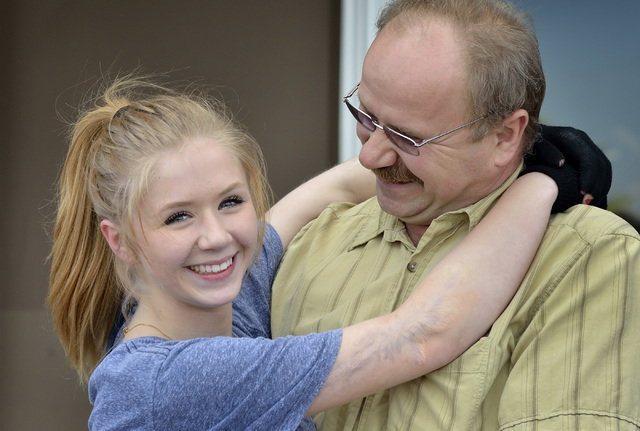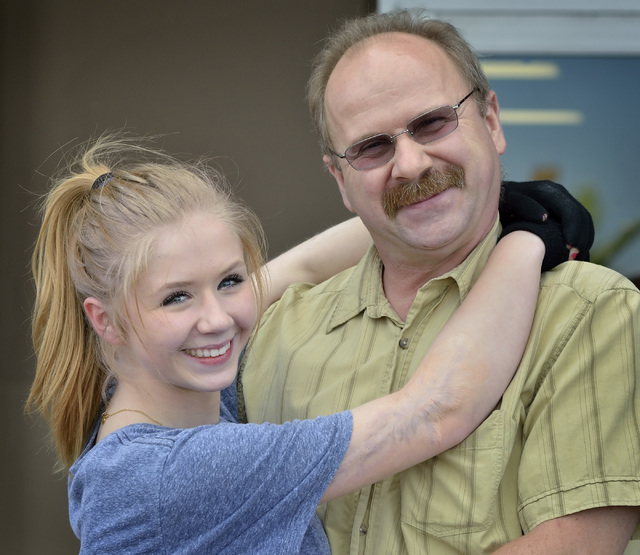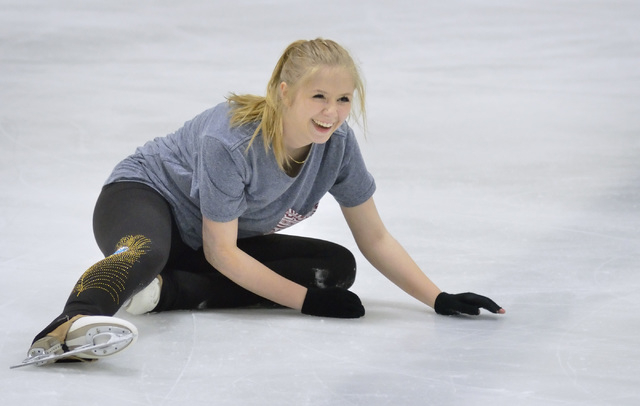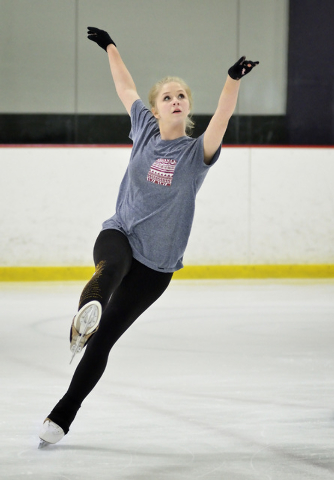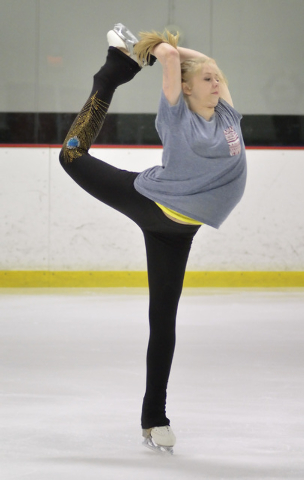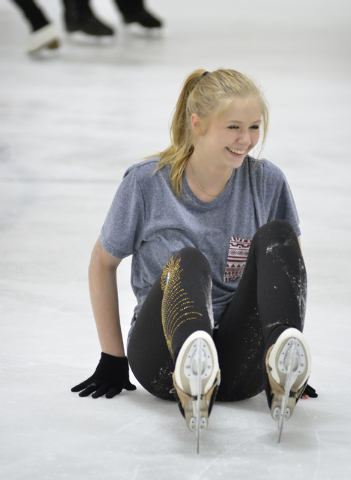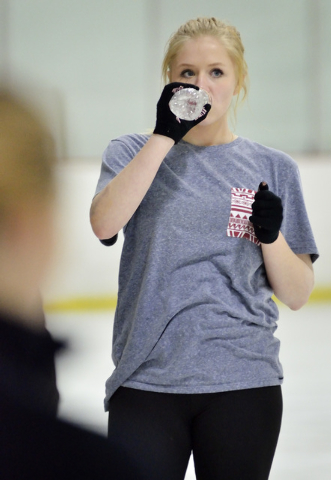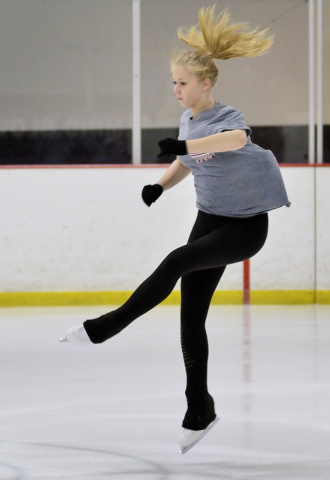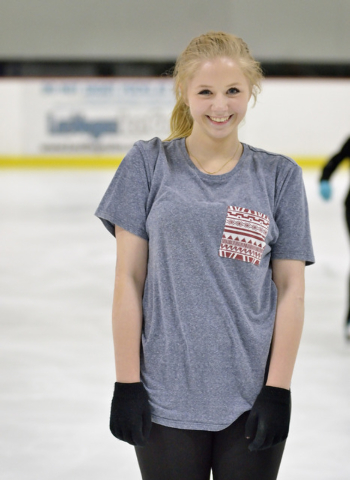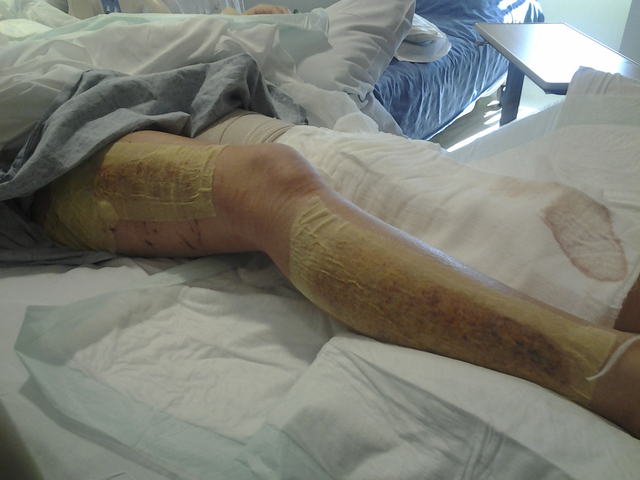Young skater conquers pavement burns to return to beloved ice
Joy.
Unbridled, unadulterated joy, the kind of innocent pleasure a baby expresses in coos and squeals as she manages to toddle across a room for the first time.
That’s what you sense in 15-year-old Michelle Rudzki as she skates at the Las Vegas Ice Center on West Flamingo Road.
She heads into a spin with a smile, and as she pulls a leg above her head from behind, she’s laughing loudly enough to be heard from halfway across the ice.
Even on the one occasion during an hourlong practice session when she falls, she giggles.
“She always love skate since little girl,” her Polish-born father, Marek Rudzki, says in broken English. “Even if she no wins medals or ribbons, she just loves.”
Less than a year ago, however, Michelle Rudzki thought about quitting what her dad said she seemed to want to do all day and all night since she was 4 years old.
Burns, or rather scars from burns, were the reason.
Burns, as strange as it may seem, that apparently were brought about by dehydration.
“I had either been teaching skating or taking lessons myself all day long and I guess I didn’t drink enough water,” Michelle Rudzki says, shaking her head as though she still can’t believe what happened. “After I got home, I decided to go over to a friend’s house. I was walking and felt perfectly fine, but I guess I fainted from dehydration and fell on the hot sidewalk. And the next thing I know I wake up and have burns on my arm and legs.”
Burns from the pavement so severe last July that she ended up in the University Medical Center’s trauma and burn unit. Tests done on her at the hospital, including brain scans, pointed to no reason for her losing consciousness other than dehydration.
“She ended up having at least 10 surgeries for second-degree burns that were close to the worst, third-degree, and she had some skin grafts, ” says Dr. Jay Coates, director of UMC’s burn care center. “Most burn centers around the country are more busy in the winter, but we’re just as busy in the summer here because of pavement burns. I’d say we have at least 50 bad cases each summer.”
Many severe burn cases, Coates says, involve people trying to run across asphalt parking lots that researchers have found reach more than 160 degrees during the summer.
“They get out to the middle and realize what they’ve done, but by then it’s too late and they have to keep going,” says Coates, who says those burns are usually of the second- degree variety. “You can’t run on pavement or asphalt in Las Vegas without ending up in the emergency room.”
The kind of sidewalk pavement that Rudzki fell on near Tropicana Avenue and the 215 Beltway often reaches near 150 degrees.
“They could tell from the severity of my burns,” Rudzki says, “that I been on the pavement between five and 10 minutes.”
Coates says it doesn’t take long for mild to moderate dehydration — with symptoms of headache, thirst and dizziness — to progress into severe dehydration, where an individual has a rapid heartbeat, fever and frequently loses consciousness.
“We see that quite a bit in Las Vegas,” he says, stressing that people living in the desert should be drinking a minimum of eight, 8-ounce glasses of water every day. “People think that because they’re inside that they’re not losing water, but they are. It’s dry in the desert, even if you’re on an ice-skating rink.”
It’s much easier, Rudzki says, to drink water than to go through the dressing changes necessary to help burns heal.
Nerve endings have been exposed, having lost their protective cover to the burn. Sometimes nurses clean a patient’s wounds of dead skin in a daily painful process called debridement, sometimes physicians do. Cries of pain can be heard from young and old alike as the procedure is done.
Coates has a special knife he uses that looks like a cheese slicer.
Although more powerful analgesics and anti-anxiety drugs combined with distraction are used to help a patient stay comfortable, Coates says just the air hitting exposed burns is enough to make the toughest person cry out.
It was nearly 10 months before she finished healing. Rudzki spent two weeks in the hospital and then had to come back to the hospital as an outpatient almost daily.
“I cried like a baby for so much of that time,” she recalls.
She isn’t sure she could have gotten through it without UMC child life specialist Kimberly Grettum.
“I now want to do the kind of work she does,” Rudzki says. “She really helps people. That’s what I’m going to go to college for.”
Day after day, Grettum talked with Rudzki as the dressing changes progressed. She also played music.
“I did whatever I could to distract her,” Grettum says. “We used an iPad a lot. There were times when she cried and I cried, too. We really bonded. I got to know who all her friends were, I saw videos of her skating. At first, she didn’t even want to see her burns, but eventually she got involved to the point where she could help change her own dressing.”
As time passed, Grettum says Rudzki became more confident.
“There was a time when she said she’d never skate again because she couldn’t wear the same outfits (because of scarring on her arms and legs),” Grettum says. “I told her I was sorry about what happened, but she couldn’t change the past, but she could create her own future. She came to realize that she could make the costumes as revealing as she wanted them to be.”
Pain from her burns wouldn’t allow her to skate for eight months, however. She also had to be home-schooled for a few months because the pain from being bumped in Durango High School’s crowded halls was too much to endure.
To this day, Rudzi is puzzled about how her burns ended up on the sides of her arms and legs, instead of the front and back.
“It’s as though I laid down on one side for a while and then another,” she says.
Another mystery is who called the first responders when she fell on the sidewalk about a block and a half from her home. Police don’t know.
Rudzki’s forced eight-month skating hiatus means she’s more winded now as she goes through her routines. She doesn’t know whether her dream of participating in the Olympics — she’s won trophies in both Nevada and Illinois — can ever be realized.
But she plans to skate for the rest of her life.
“I am lucky that my mom and dad let me find something I love to do,” she says, looking down at the new pair of white figure skates her parents purchased for her. “I feel so free when I’m on these, so fast. What a great feeling.”
Contact reporter Paul Harasim at pharasim@reviewjournal.com or 702-387-2908.



